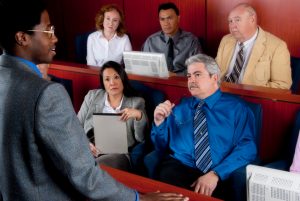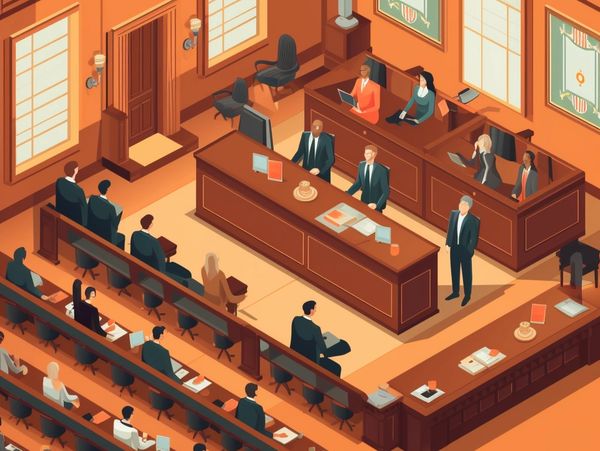From Principle to Court: Actions to Produce Powerful and Convincing Trial Presentations
From Principle to Court: Actions to Produce Powerful and Convincing Trial Presentations
Blog Article
Browsing the Complexities of Test Presentations: Tips for Seamless Delivery and Engaging Arguments
In the world of legal process, the art of trial discussion stands as a vital determinant of success. As lawyers navigate the complex web of court characteristics, the capability to flawlessly provide debates and evidence while astounding the jury's interest comes to be critical. The intricacies inherent in test discussions require a fragile equilibrium of strategy, finesse, and skill. By developing strategies that ensure a polished shipment and crafting engaging debates that resonate with the audience, legal experts can dramatically enhance their advocacy. In a world where persuasion rules supreme, understanding the intricacies of trial presentations is not simply a choice however a need for those looking for to dominate in the court room.

Understanding Trial Goals
To successfully browse a test, it is crucial to have a clear understanding of the objectives that need to be accomplished. Prior to entering the court room, lawful groups have to specify their objectives and desired outcomes. These objectives serve as directing principles throughout the trial, shaping methods and affecting decision-making procedures.
Comprehending test goals includes a detailed evaluation of the situation, legal precedents, and the client's best interests. Trial Presentations. It requires a meticulous examination of the facts, identifying key issues, and anticipating possible challenges. By establishing measurable and specific objectives, lawyers can tailor their discussions and debates to line up with the preferred results
Moreover, a clear grip of test goals allows legal groups to prioritize evidence, witnesses, and lawful disagreements efficiently. It allows for the growth of a meaningful narrative that reverberates with the court and jury, reinforcing the general case discussion.

Organizing Proof Properly
Having a clear understanding of trial purposes lays the foundation for organizing evidence effectively in lawful proceedings. By straightening the presentation of proof with the desired end results of the trial, lawful teams can reinforce their arguments and boost their persuasiveness.
Another trick element in arranging evidence successfully is establishing a rational circulation. Presenting proof in a coherent and consecutive fashion can help develop an engaging narrative that supports the lawful arguments being made. Furthermore, making use of visual help such as graphes, timelines, or graphs can further enhance the company of proof and assist in clearing up complicated partnerships or sequences of events.
Moreover, ensuring that all evidence provided is permissible and pertinent to the situation is necessary. Irrelevant or inadmissible evidence can take away from the toughness of the debate and possibly harm the trustworthiness of the offering event. Consequently, a meticulous review and selection process ought to be embarked on to consist of just one of the most legitimately audio and impactful proof in the test presentation.
Crafting Convincing Narratives
Crafting compelling narratives plays a critical function in providing convincing debates throughout lawful process. A well-crafted story has the power to astound the target market, stimulate feelings, and inevitably guide the choice in support of the offering event. When building a story for a trial presentation, it is necessary to develop a clear story that highlights bottom lines and links them in a meaningful way. Begin by detailing the truths of the case in a compelling manner, ensuring that the series of occasions is simple to comply with. Introduce characters properly, giving history info that helps the audience recognize their actions and inspirations. Furthermore, integrating vibrant summaries and interesting language can bring the narrative to life, making it more remarkable for the court and jury. By weaving with each other proof, testimony, and lawful debates into a natural and influential story, attorneys can successfully support for their this clients and raise the probability of a beneficial end result in the court.
Understanding Visual Aids
Efficient use visual aids is crucial to enhancing the impact and clearness of test discussions. Visual aids, when used purposefully, have the power to simplify complex info, enhance key points, and leave an enduring impact on the court and court. To master visual aids in trial discussions, it is critical to ensure that they are clear, concise, and relevant to the disagreements being made.
When integrating aesthetic help, such as graphes, photographs, graphs, or timelines, into a trial presentation, it is vital to keep them visually appealing yet professional. The visuals should complement the verbal arguments, offering a visual representation of the information being discussed without overwhelming the target market with unneeded information.
Additionally, exercising with the visual aids beforehand is vital to guarantee a seamless delivery throughout the test. Acquainting oneself with the material, transitions, and timings of each visual help can assist preserve the flow of the presentation and protect against technological glitches that may arise.
Supplying Impactful Closing Debates
A compelling closing argument works as the end result of a trial presentation, enveloping the core narrative and persuading the court and court towards a favorable choice. To provide an impactful closing argument, it is critical to succinctly evaluate essential points, highlight the toughness of your situation, and address any kind of weaknesses in a strategic fashion. Begin by describing the main disagreements that support your customer's position, stressing why the evidence offered throughout the trial sustains your narrative. It is essential to develop a sense of communication and clarity, leading the discretionary towards the wanted conclusion.
Furthermore, integrating psychological charm can better reinforce your closing debate. Inevitably, a well-crafted closing argument should leave a long this article lasting impression, compelling the judge and jury to rule in your client's support.
Final Thought
In verdict, understanding test discussions includes comprehending goals, organizing evidence, crafting narratives, utilizing visual aids, and supplying impactful closing debates. By applying these approaches properly, legal representatives can offer their situation effortlessly and make compelling arguments in the courtroom. It is crucial to browse the intricacies of trial presentations with precision and ability to accomplish success in legal proceedings.
By straightening the discussion of evidence with the desired outcomes of the test, legal teams can reinforce their disagreements and improve their persuasiveness (Trial Presentations). To master aesthetic aids in trial discussions, it is vital to guarantee that they are clear, concise, and pertinent to the disagreements being made
A compelling closing debate serves as the culmination of a test presentation, enveloping the core story and persuading the court and jury in the direction of a positive decision. Begin by laying out the primary arguments that sustain your client's placement, emphasizing why the proof provided throughout the test supports your story.In final thought, understanding trial discussions includes recognizing goals, arranging evidence, crafting stories, utilizing review aesthetic aids, and providing impactful closing arguments.
Report this page